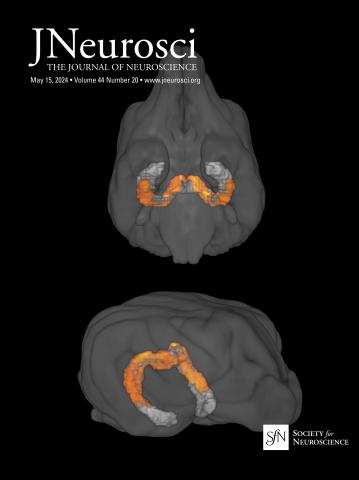Basal forebrain-ventral tegmental area glutamatergic pathway promotes emergence from isoflurane anesthesia in mice.
IF 4.4
2区 医学
Q1 NEUROSCIENCES
引用次数: 0
Abstract
Recent evidence highlights the importance of glutamatergic neurons in the basal forebrain (BF) in promoting cortical activity; however, whether BF glutamatergic neurons are involved in regulating general anesthesia and the underlying neural circuits remains unclear. Here, the authors show that the activity of BF glutamatergic neurons decreased during the induction of isoflurane anesthesia and restored during the emergence in mice. Optogenetic activation of BF glutamatergic neurons accelerated the emergence from isoflurane anesthesia, decreased isoflurane sensitivity, and increased arousal score of mice. Moreover, optogenetic activation of BF glutamatergic neurons decreased EEG delta power and burst-suppression ratio, while increased pupil size and respiration rate of mice during isoflurane anesthesia. Similar results were observed during the optogenetic activation of BF glutamatergic terminals in the ventral tegmental area (VTA). Additionally, the authors found that the activity of BF glutamatergic neurons and VTA glutamatergic neurons synchronously fluctuate during isoflurane anesthesia, and optogenetic activation of BF glutamatergic terminals in the VTA potently increased the calcium signals of VTA glutamatergic neurons during isoflurane anesthesia. Collectively, their study illustrated that BF glutamatergic neurons promote isoflurane anesthesia emergence via activating VTA glutamatergic neurons. Both male and female mice were used in this study.Statement of Significance General anesthesia is widely used in modern medicine; however, its specific neural mechanisms remain poorly understood. The basal forebrain (BF) is a critical component of the ascending arousal system, and its glutamatergic neurons were implicated in sleep-wake behavior and cortical activity. Here, we report that optogenetic activation of BF glutamatergic neurons significantly promoted cortical activation, behavioral emergence and physiological indicators in mice under isoflurane anesthesia. Photostimulation of BF glutamatergic terminals in the ventral tegmental area (VTA) produced similar effects, and significantly increased the activity of VTA glutamatergic neurons. Our findings illustrated that BF glutamatergic neurons promote emergence from isoflurane anesthesia via VTA glutamatergic neurons, highlighting a potential target for attenuating anesthesia depth and accelerating anesthesia emergence in clinical anesthesia.基底前脑-腹侧被盖区谷氨酸能通路促进异氟醚麻醉小鼠苏醒。
最近的证据强调了基底前脑(BF)中谷氨酸能神经元在促进皮层活动中的重要性;然而,BF谷氨酸能神经元是否参与调节全身麻醉和潜在的神经回路尚不清楚。本研究表明,异氟醚麻醉诱导小鼠BF谷氨酸能神经元的活性下降,并在羽化过程中恢复。光遗传学激活BF谷氨酸能神经元加速异氟烷麻醉小鼠的苏醒,降低异氟烷敏感性,提高唤醒评分。此外,异氟醚麻醉小鼠BF谷氨酸能神经元的光遗传激活降低了EEG δ功率和爆发抑制比,同时增加了瞳孔大小和呼吸频率。在腹侧被盖区(VTA) BF谷氨酸末端的光遗传激活过程中也观察到类似的结果。此外,作者还发现,在异氟醚麻醉期间,BF谷氨酸能神经元和VTA谷氨酸能神经元的活性同步波动,并且在异氟醚麻醉期间,VTA BF谷氨酸能末端的光遗传激活可显著增加VTA谷氨酸能神经元的钙信号。总的来说,他们的研究表明BF谷氨酸能神经元通过激活VTA谷氨酸能神经元来促进异氟醚麻醉的出现。本研究使用了雄性和雌性小鼠。全身麻醉在现代医学中应用广泛;然而,其具体的神经机制仍然知之甚少。基底前脑(BF)是上升觉醒系统的重要组成部分,其谷氨酸能神经元与睡眠-觉醒行为和皮层活动有关。本研究报告了异氟醚麻醉小鼠BF谷氨酸能神经元的光遗传激活可显著促进皮质激活、行为涌现和生理指标。光刺激腹侧被盖区(VTA) BF谷氨酸能末端产生类似的效果,并显著增加VTA谷氨酸能神经元的活性。我们的研究结果表明BF谷氨酸能神经元通过VTA谷氨酸能神经元促进异氟醚麻醉后的苏醒,这突出了临床麻醉中减轻麻醉深度和加速麻醉苏醒的潜在靶点。
本文章由计算机程序翻译,如有差异,请以英文原文为准。
求助全文
约1分钟内获得全文
求助全文
来源期刊

Journal of Neuroscience
医学-神经科学
CiteScore
9.30
自引率
3.80%
发文量
1164
审稿时长
12 months
期刊介绍:
JNeurosci (ISSN 0270-6474) is an official journal of the Society for Neuroscience. It is published weekly by the Society, fifty weeks a year, one volume a year. JNeurosci publishes papers on a broad range of topics of general interest to those working on the nervous system. Authors now have an Open Choice option for their published articles
 求助内容:
求助内容: 应助结果提醒方式:
应助结果提醒方式:


